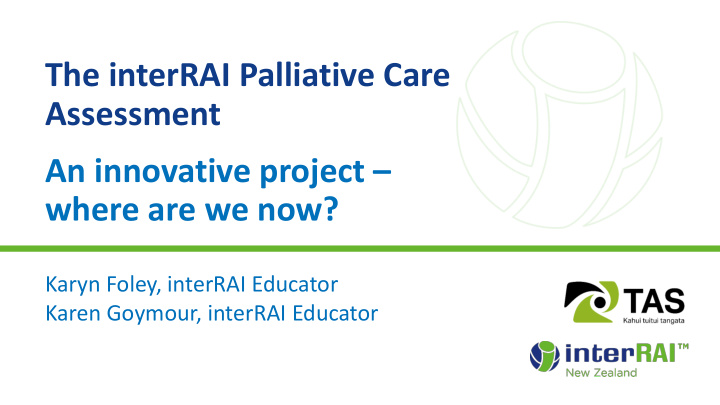



The interRAI Palliative Care Assessment An innovative project – where are we now? Karyn Foley, interRAI Educator Karen Goymour, interRAI Educator
What is interRAI Inter national Best practice Comprehensive R esident approach to clinical assessment A ssessment assessing people’s tools I nstrument needs Standardised and Common language, designed for common measures, www.interRAI.co.nz specific groups common concepts 2 2
??? Physio Provider CLINICAL TIME AND RESOURCES therapist Nurse Occupational ARC Nurse Therapist District NASC Nurse Practice Hospice Social Palliative Care Community Nurse Nurse Worker Nurse MULTIPLE ASSESSMENTS, ACROSS DIFFERENT ORGANISATIONS = STORY POTENTIALLY RETOLD MANY TIMES Icon made by https://www.flaticon.com/authors/smashicons CC 3.0 BY
How it works Same assessment across New Zealand Assessments follow the person 10% of over 65s in New Zealand Information publically available Evidence based decisions 4 4
interRAI Palliative Care Pilot December 2015-December 2016 To test the use of the interRAI Palliative Care (PC and Hospice) assessments for: • people with a prognosis of less than a year to live • who are living in the community • who would otherwise have been assessed with an interRAI Home Care assessment to identify their support needs.
Prerequisites and competencies Level one ACP or 2-hour training Homecare trained DHB equivalent programme training Clinical assessment Palliative Care on- Competency reviewed by line evaluation interview Educator
Assessments completed So far: • 142 assessors either trained or about to be trained in New Zealand • 979 Assessments completed
Assessors’ goal: Wellness for all Improving symptoms Addressing mental and physical health problems Assisting in coming to terms with death Enhancing comfort Improving quality of life 8
Useful language – talk about: Focus is not curative/not rehabilitative Limited Focus on treatment quality of life Focus on options symptom management/ Supportive treating Living well symptoms care for now As you near the Age related end of this Comfort concerns care journey…… 9
“Data! Data! Data!” he cried impatiently. “I can’t make bricks without clay.” Sir Arthur Conan Doyle: Sherlock Holmes 10
Assessors complete their assessments in: Hospital: 9% Hospice: 18% Community: 73%
PC assessed population demographics – age 40% 34% 35% 33% Percentage of Assessments 30% 25% 20% 15% 15% 9% 10% 7% 5% 2% 0% <50 50-59 60-69 70-79 80-89 90+ Age groups 12
PC assessed population demographics – ethnicity 100% 89% 90% Percentage of Assessments 80% 70% 60% 50% 40% 30% 20% 9% 10% 1% 1% 0% Asian Maori European/Other Pacific Peoples Ethnicity 13
PC assessed population – estimated survival 47% 50% 45% Percentage of Assessments 40% 40% 35% 30% 25% 20% 15% 12% 10% 5% 0% 0% Death imminent Less than 6 weeks Between 6 weeks 6 months or longer (within days) and 6 months Estimated survival time 14
PC assessed population: when pain is present 60% 55% 50% PC assessed population 40% 28% 30% 20% 13% 10% 4% 0% 0. No pain 1. With movement 2. At rest 3. Both
PC assessed population: problem frequency 100% Percentage of Assessments 75% 50% 56% 25% 39% 27% 26% 13% 0% C6g Nausea C6l Dry mouth C6m Excessive Cachexia/wasting Reports persistent sweating thirst Problem frequency
Top areas for interventions – Clinical Assessment Protocols (CAPs) 100% Percentage of Assessments 75% 62% 50% 30% 19% 30% 52% 25% 18% 15% 3% 30% 23% 22% 15% 14% 11% 11% 8% 0% PC Fatigue PC Nutrition PC Mood PC Pain PC Dyspnoea PC Sleep Communication Delirium PC PressureUlcer CAPs Trigger level 1 Trigger level 2
Psychosocial well-being 100% Percentage of Assessments 75% 50% 75% 70% 25% 0% I1a Completion of responsibilities I1c Accepting of situation Life completion 18
Self-reported spirituality 0. No 1. Yes 8. Person could not (would not) respond PERCENTAGE OF ASSESSMENTS 33% 35% 39% 5% 32% 54% 56% 36% 11% I2A GUIDANCE IN RELIGION I2B STRUGGLING WITH I2D AT PEACE WITH LIFE MEANING OF LIFE SELF-REPORTED SPIRITUALITY 19
Legal responsibilities 100% Percentage of Assessments 75% 50% 62% 25% 14% 0% N1a EPOA N2a Advance Care Plan EPOA/ACP 20
Person’s wish 100% Percentage of Assessments 33% 40% 75% 10% 50% 31% 56% 25% 28% 0% N3a Wishes to die at home N3c Wants to die now Wishes regarding where to die 0. No 1. Yes 8. Unable to determine 21
Social supports – time with person 100% 75% Percentage of Assessments 50% 60% 25% 31% 2% 7% 0% 0. No contact 1. Less than 1 hour 2. 1-4 hours 3. More than 4 hours Time with person 22
Social supports – family carer status 100% Percentage of Assessments 75% 50% 92% 25% 50% 28% 0% O4a Strengths - Strong and O4c Primary informal helper O4d Unsettled relationships - supportive relationship with expresses feelings of distress, Family or close friends report family anger, or depression feeling overwhelmed by person’s support needs Social supports 23
Depression Rating Scale (0-14) 60% 50% 40% 30% 20% 10% 0% 0 1 2 3 4 5 6 7 8 9 10 11 12 13 14 Depression Rating Scales 24
Pressure Ulcer Risk (0-8) 30% 25% 20% 15% 10% 5% 0% 0 1 2 3 4 5 6 7 8 Pressure Ulcer Risk 25
Pain Scale (0-4) 35% 30% 25% 20% 15% 10% 5% 0% 0 1 2 3 4 Pain Scale 26
www.interrai.co.nz
Recommend
More recommend